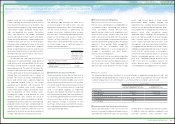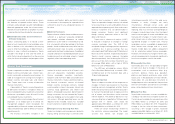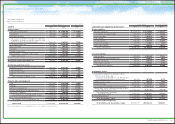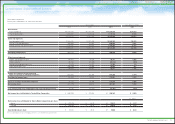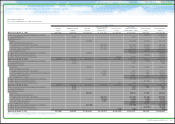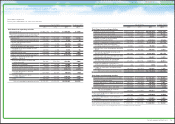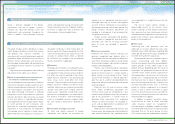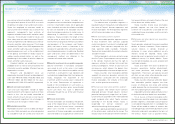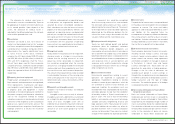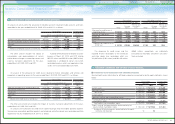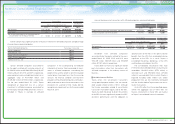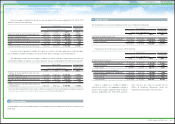Toyota 2011 Annual Report Download - page 77
Download and view the complete annual report
Please find page 77 of the 2011 Toyota annual report below. You can navigate through the pages in the report by either clicking on the pages listed below, or by using the keyword search tool below to find specific information within the annual report.
0822
Financial Section and
Investor Information
Business and
Performance Review
Special FeatureMessage/Vision
Management and
Corporate Information
Notes to Consolidated Financial Statements
compliance with terms and conditions of the
underlying loan agreement and other subjective
factors related to the financial stability of the
borrower are considered when determining
whether a loan is impaired. Impaired finance
receivables include certain nonaccrual receivables
for which a specific reserve has been assessed.
Impaired receivables are excluded from the loan
risk pool used to determine general reserves.
All classes of wholesale and other dealer loan
receivables portfolio segment are placed on
nonaccrual status when full payment of principal
or interest is in doubt, principal or interest is 90
days or more contractually past due, whichever
occurs first. Collateral dependent loans are
placed on nonaccrual status if collateral is
insufficient to cover principal and interest. Interest
accrued but not collected at the date a receivable
is placed on nonaccrual status is reversed against
interest income. In addition, the amortization of
net deferred fees is suspended.
Interest income on nonaccrual receivables is
recognized only to the extent it is received in cash.
Accounts are restored to accrual status only when
interest and principal payments are brought
current and future payments are reasonably
assured. Receivable balances are written-off
against the allowance for credit losses when it is
probable that a loss has been realized. Retail
receivables class and finance lease receivables
class are not placed mainly on nonaccrual status
when principal or interest is 90 days or more past
due. However, these receivables are written-off
against the allowance for credit losses when
payments due are no longer expected to be
received or the account is 120 days contractually
past due, whichever occurs first.
As of March 31, 2010, finance receivables on
nonaccrual status were ¥26,599 million.
As of March 31, 2010, finance receivables
past due over 90 days and still accruing were
¥38,150 million.
As of March 31, 2011, finance receivables
past due over 90 days and still accruing were as
follows:
As of March 31, 2011, finance receivables on
nonaccrual status were as follows:
Allowance for credit losses is established to cover
probable losses on finance receivables and
vehicles and equipment on operating leases,
resulting from the inability of customers to make
required payments.
Provision for credit losses is included in selling,
general and administrative expenses. The
allowance for credit losses is based on a
systematic, ongoing review and evaluation
performed as part of the credit-risk evaluation
process, historical loss experience, the size and
composition of the portfolios, current economic
Allowance for credit losses
Allowance for residual value losses
Yen in millions
U.S. dollars in millions
March 31, March 31,
2011 2011
Retail ¥ 2,633 $ 32
Finance leases 1,136 14
Wholesale 6,722 81
Real estate 14,437 173
Working capital 272
3
¥25,200 $303
Yen in millions
U.S. dollars in millions
March 31, March 31,
2011 2011
Retail ¥23,734 $285
Finance leases
4,484
54
¥28,218 $339
events and conditions, the estimated fair value
and adequacy of collateral and other pertinent
factors. Vehicles and equipment on operating
leases are not within the scope of accounting
guidance governing the disclosure of portfolio
segments.
Toyota calculates allowance for credit losses to
cover probable losses on retail receivables by
applying reserve rates to such receivables.
Reserve rates are calculated mainly by historical
loss experience, current economic events and
conditions and other pertinent factors.
Toyota calculates allowance for credit losses to
cover probable losses on finance lease receivables
by applying reserve rates to such receivables.
Reserve rates are calculated mainly by historical
loss experience, current economic events and
conditions and other pertinent factors such as
used car markets.
Toyota calculates allowance for credit losses to
cover probable losses on wholesale and other
dealer loan receivables by applying reserve rates
to such receivables. Reserve rates are calculated
mainly by financial conditions of the dealers, terms
of collateral setting, current economic events and
conditions and other pertinent factors.
Toyota establishes specific reserves to cover
the estimated losses on individually impaired
receivables within the wholesale and other dealer
loan receivables portfolio segment. Specific
reserves on impaired receivables are determined
by the present value of expected future cash flows
or the fair value of collateral when it is probable
Retail receivables portfolio segment
Finance lease receivables portfolio segment
Wholesale and other dealer loan receivables
portfolio segment
that such receivables will be unable to be fully
collected. The fair value of the underlying collateral
is used if the receivable is collateral-dependent.
The receivable is determined collateral-dependent
if the repayment of the loan is expected to be
provided by the underlying collateral. For the
receivables in which the fair value of the underlying
collateral was in excess of the outstanding
balance, no allowance was provided.
Specific reserves on impaired receivables
within the wholesale and other dealer loan
receivables portfolio segment are recorded by an
increase to the allowance for credit losses based
on the related measurement of impairment.
Related collateral, if recoverable, is repossessed
and sold and the account balance is written-off.
Any shortfall between proceeds received and
the carrying cost of repossessed collateral is
charged to the allowance. Recoveries are reversed
from the allowance for credit losses.
Toyota is exposed to risk of loss on the disposition
of off-lease vehicles to the extent that sales
proceeds are not sufficient to cover the carrying
value of the leased asset at lease termination.
Toyota maintains an allowance to cover probable
estimated losses related to unguaranteed residual
values on its owned portfolio. The allowance is
evaluated considering projected vehicle return
rates and projected loss severity. Factors
considered in the determination of projected return
rates and loss severity include historical and
market information on used vehicle sales, trends
in lease returns and new car markets, and general
economic conditions. Management evaluates the
foregoing factors, develops several potential loss
scenarios, and reviews allowance levels to
determine whether reserves are considered
adequate to cover the probable range of losses.
77
TOYOTA ANNUAL REPORT 2011



